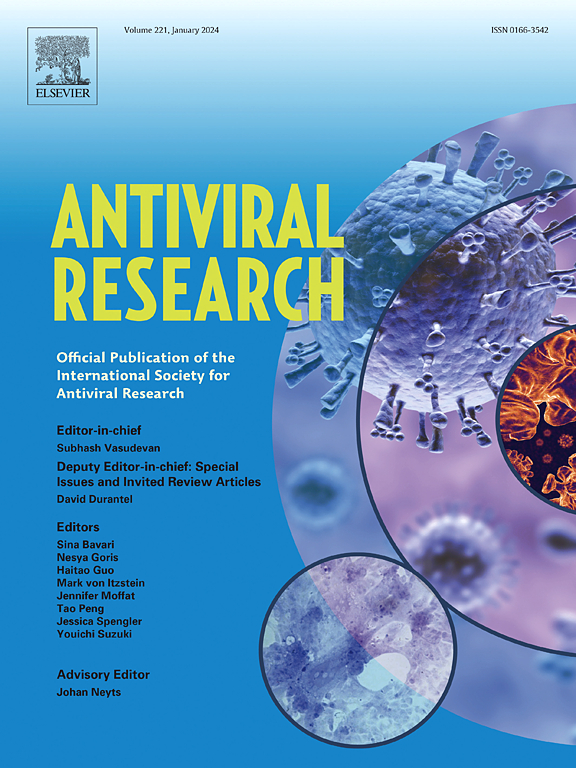揭示SARS-CoV-2的心脏:SARS-CoV-2 RNA依赖性RNA聚合酶的作用、结构和抑制
IF 4.5
2区 医学
Q1 PHARMACOLOGY & PHARMACY
引用次数: 0
摘要
2019年底SARS-CoV-2的出现对病毒学研究和开发新型和重新用途的抗病毒药物构成了巨大的挑战。在目标病毒蛋白中,一种是nsp12,它携带RNA依赖性RNA聚合酶(RdRp)活性,对病毒复制至关重要。nsp12与nsp7和nsp8辅因子一起构成了大型病毒复制和转录复合体(RTC)。nsp7和nsp8辅因子在辅助过程中起着重要作用,并与其他几种非结构蛋白(如解旋酶、甲基转移酶、内切酶和外切酶)相关。在这样的RTC中,nsp12催化了病毒世界中最长的RNA基因组之一的合成,与其他病毒RdRps相比,需要特殊的速度、处理能力和保真度。此外,冠状病毒独特的复制周期要求nsp12在病毒基因组的反向校对活动和亚基因组mrna的不连续合成过程中的“跳跃”中发挥不太传统的功能。在与RNA和抑制剂的复合物中,通过低温电子显微镜以分辨率<;3 Å解析了最小RTC的结构,为其功能和药物开发的结构研究打开了大门。鉴于其在病毒复制中的重要作用,过去几年进行了广泛的研究,以确定核苷(NI)和非核苷(NNI)抑制剂,导致两种NIs进入临床应用,尽管它们在体内的疗效仍在评估中。本文旨在总结目前已知的SARS-CoV-2 RdRp的结构和功能方面以及药物发现的最新进展。本文章由计算机程序翻译,如有差异,请以英文原文为准。
Unveiling SARS-CoV-2's heart: role, structure and inhibition of SARS-CoV-2 RNA-dependent RNA polymerase
SARS-CoV-2 emergence in late 2019 represented an incredible challenge for virological research and the development of novel as well as repurposed antiviral agents. Among the targeted viral proteins, one is nsp12 that carries the RNA-dependent RNA polymerase (RdRp) activity, essential for the viral replication. Together with nsp7 and nsp8 cofactors, having an essential role in aiding processivity and associated with several other nonstructural proteins such as helicase, methyltransferase, endo- and exonuclease, nsp12 forms the large viral replication and transcription complex (RTC). Within such RTC, nsp12 catalyzes the synthesis of one of the longest RNA genomes in the viral world, requiring exceptional speed, processivity and fidelity compared to other viral RdRps. Moreover, the peculiar replication cycle of coronaviruses requires nsp12 to perform less conventional functions in backtracking on the viral genome for proof-reading activity and “jumping” during discontinuous synthesis of subgenomic mRNAs. The structure of the minimal RTC was resolved with a resolution <3 Å by cryo-electron microscopy in complex with RNA and with inhibitors, opening the doors to structural studies on its functions and drug development. Given its essential role in viral replication, extensive research was carried out over the last years to identify both nucleoside (NI) and non-nucleoside (NNI) inhibitors, resulting in two NIs reaching clinical use, although their efficacy in vivo is still under evaluation. This review aims at summarizing the currently known structural and functional aspects and the state-of-the art in drug discovery for SARS-CoV-2 RdRp.
求助全文
通过发布文献求助,成功后即可免费获取论文全文。
去求助
来源期刊

Antiviral research
医学-病毒学
CiteScore
17.10
自引率
3.90%
发文量
157
审稿时长
34 days
期刊介绍:
Antiviral Research is a journal that focuses on various aspects of controlling viral infections in both humans and animals. It is a platform for publishing research reports, short communications, review articles, and commentaries. The journal covers a wide range of topics including antiviral drugs, antibodies, and host-response modifiers. These topics encompass their synthesis, in vitro and in vivo testing, as well as mechanisms of action. Additionally, the journal also publishes studies on the development of new or improved vaccines against viral infections in humans. It delves into assessing the safety of drugs and vaccines, tracking the evolution of drug or vaccine-resistant viruses, and developing effective countermeasures. Another area of interest includes the identification and validation of new drug targets. The journal further explores laboratory animal models of viral diseases, investigates the pathogenesis of viral diseases, and examines the mechanisms by which viruses avoid host immune responses.
 求助内容:
求助内容: 应助结果提醒方式:
应助结果提醒方式:


